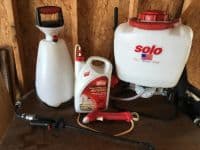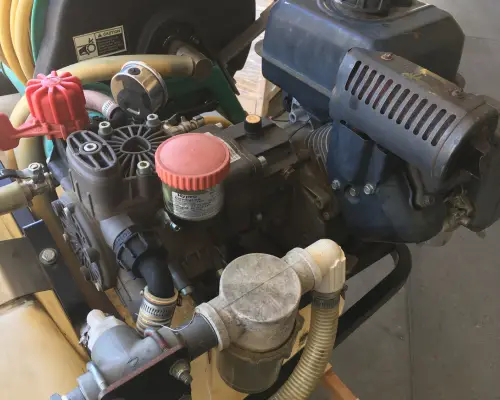A tank sprayer is an indispensable tool for a variety of applications, from applying fertilizers to controlling pests. But what exactly is a tank sprayer, and how can it benefit your gardening and lawn care routine? Let’s explore.
What is a Tank Sprayer?
tank sprayer Is a term used to describe any sprayer used by hand or the liquid is contained in a tank. It covers a wide range of different sprayer types including hand pump sprayers backpack sprayers, skid sprayers, cart sprayers, etc. Often it is used to describe a simple sprayer used by hand made up of a tank hose and spray wand with a small pump assembly inside the tank.
This is often in contrast with a hose and sprayer or boom sprayer. The name comes from the most prominent part of the sprayer, in this case, the tank. We’re on a boom sprayer a large boom might be the most prominent feature and on the hose and sprayer the garden hose supplies the liquid in the most prominent Aspect of the sprayer being that it fits on the end of the garden hose
Key Components of a Tank Sprayer:
- Tank: The container that holds the liquid mixture. Sizes vary
- Pump: Used to pressurize the liquid in the tank.
- Wand: The piece of the sprayer that is handled by the operator. It serves as a trigger to control when fluid is dispersed.
- Nozzle: The smallest piece on the end of the wand regulates the flow and determines the actual spray pattern and drop size.

Types of Tank Sprayers
There are several types of tank sprayers. They can be divided into three different types. Each of these types contains different variations. These are the main types:
Manual Tank Sprayers
These include any sprayer that requires the user to physically pump to build pressure. Ideal for small to medium-sized areas.
Examples of manual tank sprayers:
- Hand pump tank sprayers
- Backpack sprayers

Operating Manual Tank Sprayers
Storage and Mixing: The tank of the sprayer serves as a reservoir for the liquid solution. This is where you can mix water with concentrated chemicals like herbicides or pesticides. The size of the tank varies depending on the sprayer type, typically ranging from 1-3 gallons.
Pressure System: Most tank sprayers use a simple pump module to create pressure and distribute the liquid. This is achieved manually, like in hand-pumped sprayers or backpack sprayers
Control and Distribution: The liquid is then pushed through a hose and out of a nozzle at the end. A trigger wand is a mechanism that allows the user to turn the spray “on or off”. The type of nozzle and the pressure control the distribution pattern and droplet size, which are crucial for effective application. For instance, a fine mist can be effective at coating plant tissue, while a more direct stream could be appropriate for penetrating plant canopy and soaking the ground.
These sprayers excel at almost all of the spraying tasks you may have around a home or small garden. They can be used to target specific areas or broadcast spray the entirety of a smaller lawn.
Electronic Tank Sprayers
Use a battery-operated pump for easier and more consistent pressure. Here are some examples:
- Battery-powered hand sprayers
- Battery-powered backpack sprayers
- 12 V spot sprayers
Many battery-powered tank sprayers utilize a small electronic pump. These offer more consistent pressure compared to a manual tank sprayer. The pump provides a constant flow rate so unlike a manual tank sprayer, the pressure does not drop as you spray. A manual tank sprayer requires repeated pumping of the handle to keep the pressure up and maintain the spray pattern and flow rate.
Other than the battery-powered pump, the rest of the unit is often the same as a manual tank sprayer although there are larger units. Manual sprayers are limited in their tank size because, at a certain point, it would take too long to “build up” pressure inside the tank.
With an electric pump, the tank can essentially be as large as needed. Many battery-powered tank sprayers are the same as the 1-3 gallon hand pump sprayers but with a different pump assembly.
Other versions have a much larger tank and pump. The pump is typically a 12-volt powered pump. This type of sprayer is often called a spot sprayer. They typically range from 15-25 gallons and are used on ATVs and lawnmowers where a 12-volt battery is easily accessible.
They are suited for similar applications as smaller manual tank sprayers but they can be used to tackle larger areas because they are less physically demanding on the user. They tend to offer a more even application of chemical products as well. The consistent flow from the pump means there is less variance in the amount of liquid that gets applied in a certain area as you spray.
Engine-Driven Tank Sprayers
These are best for large areas or commercial use, offering high power and capacity. These are the different types:
- Turf Spray rigs
- Tree spray rigs
- Commercial trailer sprayers

Maybe not the first type of sprayer that comes to mind when you hear “tank sprayer”, but these certainly can be considered in the family. They are often called spray “rigs” or “skids”. There really is no official definition but it helps to work out what someone means when they use one of these terms.
This type of sprayer is used for commercial spraying. The size and scale of the applications require higher flow and higher pressure pumps that battery-powered pumps don’t offer. That is why they need engine-driven pumps.
For more details read this article on commercial sprayer rigs.
Advantages of Using a Tank Sprayer
- Precision: Allows for accurate application of chemicals, reducing waste and environmental impact.
- Adjustability: Many models offer adjustable pressure settings and nozzles for different application needs.
- Versatility: Suitable for a wide range of liquids and various lawn and garden tasks.
- Capacity Options: Available in various sizes to suit different needs, from small gardens to large estates.
Considerations When Using a Tank Sprayer
- Safety: Always wear appropriate protective gear and follow safety guidelines, especially when handling chemicals.
- Maintenance: Regular cleaning and maintenance are crucial to ensure longevity and performance.
- Environment: Be mindful of weather conditions and surroundings to prevent drift and protect beneficial insects and plants.
What Does a Tank Sprayer Do?
A tank sprayer, often a key tool in lawn care, gardening, agriculture, and pest control, is designed to apply liquids such as water, herbicides, pesticides, and fertilizers. Its primary function is to distribute these liquids evenly and efficiently over a specific area.
Tank sprayers are versatile and able to tackle a wide variety of tasks. There are a wide variety of different types that are constructed for specific tasks.
How Does a Tank Sprayer Work?
A basic hand pump tank sprayer can disperse liquid because the operator manually works the handle to build pressure inside the tank. The sprayer is sealed up and the trigger wand keeps all the pressure trapped in the sprayer until the user pulls the trigger.
This is the case for a hand pump sprayer or backpack sprayer. Be sure to read our hand pump and backpack sprayer repair guides for a more detailed description and diagrams of how these sprayers work:
Pump Sprayer Won’t Build Pressure
Backpack Sprayer Won’t Build Pressure
Conclusion
A tank sprayer is a versatile and efficient tool for anyone serious about lawn care and gardening. By understanding the different types and features, as well as the importance of safe and proper usage, you can select the perfect tank sprayer for your needs. Whether you’re maintaining a small backyard or managing large landscapes, a tank sprayer can be your ally in achieving a healthy and beautiful outdoor space.

